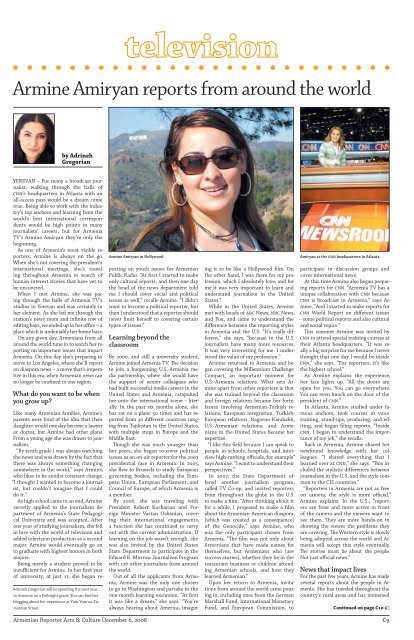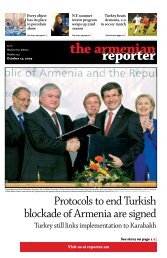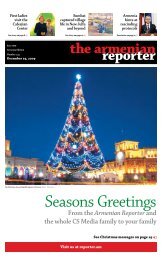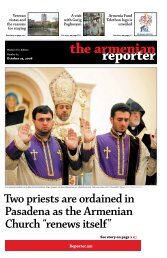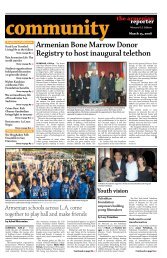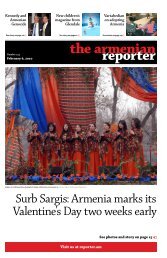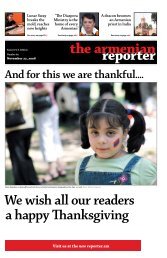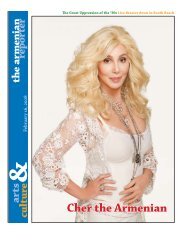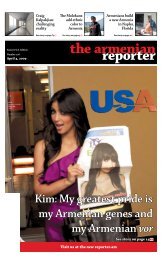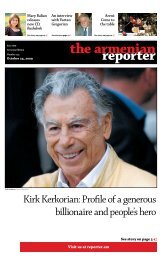You also want an ePaper? Increase the reach of your titles
YUMPU automatically turns print PDFs into web optimized ePapers that Google loves.
televisionArmine Amiryan reports from around the worldby AdrinehGregorianYEREVAN – For many a broadcast journalist,walking through the halls ofcnn’s headquarters in Atlanta with anall-access pass would be a dream cometrue. Being able to work with the industry’stop anchors and learning from theworld’s best international correspondentswould be high points in manyjournalists’ careers, but for ArmeniaTV’s Armine Amiryan they’re only thebeginning.As one of Armenia’s most visible reporters,Armine is always on the go.When she’s not covering the president’sinternational meetings, she’s travelingthroughout Armenia in search ofhuman -interest stories that have yet tobe uncovered.When I met Armine, she was pacingthrough the halls of Armenia TV’sstudios in Yerevan and was certainly inher element. As she led me through thestation’s news room and infinite row ofediting bays, we ended up in her office – aplace which is undeniably her home base.On any given day, <strong>Armenian</strong>s from allaround the world tune in to watch her reportingon important issues that impactArmenia. On this day she’s preparing tomove to Los Angeles, where she’ll reporton diaspora news – a move that’s imperativein this era, when <strong>Armenian</strong> news canno longer be confined to one region.What do you want to be whenyou grow up?Adrineh Gregorian will be spending the next yearin Armenia on a Fulbright grant. You can find herblogging about her experience at Yum Yum on TumanyanStreet.Armine Amiryan in Hollywood.Like many <strong>Armenian</strong> families, Armine’sparents were fond of the idea that theirdaughter would one day become a lawyeror doctor, but Armine had other plans.From a young age she was drawn to journalism.“By tenth grade I was always watchingthe news and was drawn by the fact thatthere was always something changingsomewhere in the world,” says Armine,who likes to be amidst constant change.“I thought I wanted to become a journalist,but couldn’t imagine that I coulddo it.”As high school came to an end, Arminesecretly applied to the journalism departmentof Armenia’s State PedagogicalUniversity and was accepted. Afterone year of studying journalism, she fellin love with the world of television andadded television production as a secondmajor. Armine would eventually go onto graduate with highest honors in bothmajors.Being merely a student proved to beinsufficient for Armine. In her first yearof university, at just 17, she began reportingon youth issues for <strong>Armenian</strong>Public Radio. “At first I started to makeonly cultural reports, and then one daythe head of the news department toldme I should cover social and politicalissues as well,” recalls Armine. “I didn’twant to become a political reporter, butthen I understood that a reporter shouldnever limit herself to covering certaintypes of issues.”Learning beyond theclassroomBy 2000, and still a university student,Armine joined Armenia TV. The decisionto join a burgeoning U.S.-Armenia mediapartnership, where she would havethe support of senior colleagues whohad built successful media careers in theUnited States and Armenia, catapultedher onto the international scene – literally.In the past six months alone, shehas sat on a plane 50 times and has reportedfrom 30 different countries rangingfrom Tajikistan to the United States,with multiple stops in Europe and theMiddle East.Though she was much younger thanher peers, she began to cover politicalissues as an on-air reporter for the 2003presidential race in Armenia. In 2005,she flew to Brussels to study Europeangoverning bodies, including the EuropeanUnion, European Parliament, andCouncil of Europe, of which Armenia isa member.By 2006, she was traveling withPresident Robert Kocharian and ForeignMinister Vartan Oskanian, coveringtheir international engagements,a function she has continued to carryout with the current administration. Iflearning on the job wasn’t enough, shewas also invited by the United StatesState Department to participate in theEdward R. Murrow Journalism Programwith 126 other journalists from aroundthe world.Out of all the applicants from Armenia,Armine was the only one chosento go to Washington and partake in theone-month learning excursion. “At firstit was like a dream,” she says. “You’realways hearing about America, imaginingit to be like a Hollywood film. Onthe other hand, I was there for my profession,which I absolutely love, and forme it was very important to learn andunderstand journalism in the UnitedStates.”While in the United States, Arminemet with heads of abc News, nbc News,and Fox, and came to understand thedifference between the reporting stylesin Armenia and the U.S. “It’s really different,”she says, “because in the U.S.journalists have many more resources.It was very interesting for me. I understoodthe value of my profession.”Armine returned to Armenia and begancovering the Millennium ChallengeCompact, an important moment forU.S.-Armenia relations. What sets Armineapart from other reporters is thatshe was trained beyond the classroomand foreign relations became her forte.Issues involving <strong>Armenian</strong>-Turkish relations,European integration, Turkish-European relations, Nagorno-Karabakh,U.S.-<strong>Armenian</strong> relations, and <strong>Armenian</strong>sin the United States became herexpertise.“I like this field because I can speak topeople in schools, hospitals, and interviewhigh-ranking officials, for example”says Armine. “I want to understand theirperspectives.”In 2007, the State Department offeredanother journalism program,called TV Co-op, and invited reportersfrom throughout the globe to the U.S.to make a film. “After thinking about itfor a while, I proposed to make a filmabout the <strong>Armenian</strong>-American diaspora,[which was created as a consequence]of the Genocide,” says Armine, whowas the only participant chosen fromArmenia. “The film was not only about<strong>Armenian</strong>s that have made names forthemselves, but <strong>Armenian</strong>s who [aresuccess stories], whether they be in therestaurant business or children attending<strong>Armenian</strong> schools, and how theylearned <strong>Armenian</strong>.”Upon her return to Armenia, invitationsfrom around the world came pouringin, including ones from the GermanMarshall Fund, International MonetaryFund, and European Commission, toAmiryan at the cnn headquarters in Atlanta.participate in discussion groups andcover international news.At this time Armine also began preparingreports for cnn. “Armenia TV has aunique collaboration with cnn becausecnn is broadcast in Armenia,” says Armine.“And I started to make reports forcnn World Report on different issues– some political reports and also culturaland social topics.”This summer Armine was invited bycnn to attend special training courses attheir Atlanta headquarters. “It was reallya big surprise for me because I neverthought that one day I would be insidecnn,” she says. “For reporters, it’s likethe highest school.”As Armine explains the experience,her face lights up. “All the doors areopen for you. You can go everywhere.You can even knock on the door of thepresident of cnn.”In Atlanta, Armine studied under famousanchors, took courses in voicetraining, stand-ups, producing, and editing,and began filing reports. “Insidecnn, I began to understand the importanceof my job,” she recalls.Back in Armenia, Armine shared hernewfound knowledge with her colleagues.“I shared everything that Ilearned over at cnn,” she says. “This includedthe stylistic differences betweenjournalism in the U.S. and the style commonto the CIS countries.”“<strong>Reporter</strong>s in Armenia are not as freeon camera; the style is more official,”Armine explains. In the U.S., “reportersare freer and more active in frontof the camera and the viewers want tosee them. They are more hands-on inshowing the viewer the problems theyare covering. The Western style is slowlybeing adopted across the world and Armeniawill accept this style eventually.The stories must be about the people.Not just official news.”News that impact livesFor the past few years, Armine has madeseveral reports about the people in Armenia.She has traveled throughout thecountry’s rural areas and has immersedContinued on page C10 <strong>Armenian</strong> <strong>Reporter</strong> <strong>Arts</strong> & <strong>Culture</strong> December 6, 2008C9


